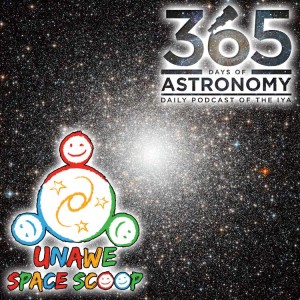Podcaster: Richard Drumm
Title: Space Scoop: The Universe’s Lost Lithium
Organization: Astrosphere New Media
Link : astrosphere.org ; http://unawe.org/kids/unawe1436/
Description: Space scoop, news for children.
Bio: Richard Drumm is President of the Charlottesville Astronomical Society and President of 3D – Drumm Digital Design, a video production company with clients such as Kodak, Xerox and GlaxoSmithKline Pharmaceuticals. He was an observer with the UVa Parallax Program at McCormick Observatory in 1981 & 1982. He has found that his greatest passion in life is public outreach astronomy and he pursues it at every opportunity.
Today’s sponsor: This episode of “365 Days of Astronomy” is sponsored by — no one. We still need sponsors for many days in 2013, so please consider sponsoring a day or two. Just click on the “Donate” button on the lower left side of this webpage, or contact us at signup@365daysofastronomy.org.
Transcript:
This is 365 Days of Astronomy. Today we bring you a new episode in our Space Scoop series. This show is produced in collaboration with Universe Awareness, a program that strives to inspire every child with our wonderful cosmos.
Today’s story is…
The Universe’s Lost Lithium
 You may have heard the phrase ‘you are made of stardust’ — and it’s true. Here are some popular culture sources for the phrase:
You may have heard the phrase ‘you are made of stardust’ — and it’s true. Here are some popular culture sources for the phrase:
“We are made of star-stuff” Carl Sagan 1973
“We are stardust.” – Joni Mitchell – 1969
Or even further back in time:
“… our bodies are made of star-stuff, – and there is nothing else, says the spectroscope, to make them of.” Albert Durrant Watson 1918
Many of the particles making up your body and the world around you, were forged in the hearts of stars billions of years ago. But there are some materials in you that have a much older origin, at the very start of the Universe.
Just a few minutes after the Big Bang, astronomers think that certain elements started forming. These include hydrogen and helium, the most common elements in the Universe along with tiny amounts of a element called lithium.
There’s a wall chart called the Periodic Table of the Elements on the wall in your school that’s a graphical representation of all the building blocks of the Universe. Hydrogen is #1, Helium #2, and Lithium is #3 in the table.
Astronomers can calculate with quite a bit of confidence exactly how much lithium there should have been in the early Universe. And from this, they can work out how much lithium we should see in old stars.
But these two numbers don’t match — there is about three times less lithium in those older stars than was expected! The reason for this remains a mystery to this day.
Up to now we’ve only been able to measure the amount of lithium in nearby stars, in the Milky Way. But a team of ESO astronomers has now managed to study the levels of lithium in a group of stars outside our Galaxy.
The crowded photograph in this episode’s album artwork shows a star cluster called Messier 54. It was discovered by comet hunter Charles Messier in 1778 and was the 54th item in his list of things that looked like comets but weren’t the comets he was hunting.
For more than two hundred years after its discovery, M54 (as it’s called) was thought to be similar to the other 150 or so globular clusters in the Milky Way. They’re called globular clusters because of the spherical shape.
But in 1994 it was discovered that it actually lies in an entirely separate galaxy, the Sagittarius Dwarf Elliptical Galaxy, which is more than three times as far from the Earth as the center of our Galaxy and judging by the name “Sagittarius” in there it’s in the direction of the center of the Milky Way too.
Do a spot of math in your head and you’ll see that puts it just outside the disk of the Milky Way on the other side of the galaxy from us.
The new study has shown that the levels of lithium in the star cluster are similar to those in the Milky Way. Now this might not sound like a big scientific breakthough to you, but it does tell us that whatever caused the low levels of lithium probably happened all over the Universe, not just in our Galaxy.
There are several possible proposed solutions to the riddle.
The first is that the calculations of the amounts of lithium produced in the Big Bang are wrong — but very recent tests suggest that this is not the case.
The second is that the lithium was somehow destroyed in the earliest stars, before the formation of the Milky Way.
The third is that some process in the stars has gradually destroyed lithium by as-yet-undetermined nuclear fusion processes.
Hey, here’s a cool fact:
You might not have heard of Lithium, but it can be found in many common items that you use every day including computers, hybrid cars and cell phone batteries.
Thank you for listening to 365 Days of Astronomy!
End of podcast:
365 Days of Astronomy
=====================
The 365 Days of Astronomy Podcast is produced by Astrosphere New Media. Audio post-production by Richard Drumm. Bandwidth donated by libsyn.com and wizzard media. You may reproduce and distribute this audio for non-commercial purposes. Please consider supporting the podcast with a few dollars (or Euros!). Visit us on the web at 365DaysOfAstronomy.org or email us at info@365DaysOfAstronomy.org. In the new year the 365 Days of Astronomy project will be something different than before….Until then…goodbye

